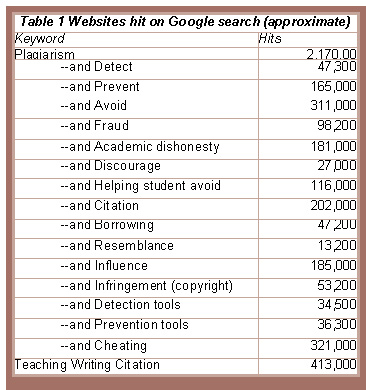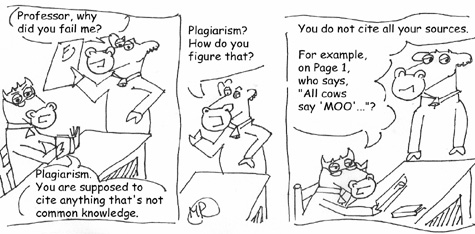Policing Plagiarism Online
By Maddalena Romano, Writing Fellow, Queens College, CUNY
The Internet has changed many things for many people. One of these changes is the increased access for students to online paper mills that sell term papers. The Internet also provides instructors with resources that ¡§detect and prevent¡¨ plagiarism, and a forum to discuss and share these resources with other instructors. In fact, searching the Internet reveals many websites dedicated to this purpose, as evidenced in Table 1 below. More interesting, however, is the dichotomy between detecting plagiarism and about plagiarism. Many academic articles have discussed this particular topic. This article, however, deals with how some Internet sites represent plagiarism, and as such, informally highlights a few websites that discuss citation and plagiarism. The framework for the description and evaluation of the websites that I am presenting in this article is based on the following set of questions:
- How does this site represent citation and plagiarism?
- What is the target audience?
- How are the views articulated in this site connected to knowledge-making?
In beginning this survey, it was at first useful to perform a Google? search (http://www.google.com) on the word ¡§plagiarism.¡¨ This proved enlightening, since over 2,170,000 websites were found. From that point forward, one additional keyword was added to see if a more manageable number of hits could be obtained. Again, as Table 1 below shows, this also proved to be revealing.
Representation of citation and plagiarism

The language of most of these websites reads like a police report or legal document. Words such as ¡§cheating,¡¨ ¡§fraud,¡¨ ¡§dishonesty,¡¨ ¡§prevention,¡¨ and ¡§detection¡¨ prevail¡Xall of which harbor highly negative connotations. Furthermore, there seems to be no clear way of communicating how to properly cite sources. For instance, a pamphlet from the University of Indiana (http://www.indiana.edu/~wts/pamphlets/plagiarism.shtml) says that to avoid plagiarizing, one must credit direct quotes, theories, diagrams, and paraphrases of another¡¦s words. An article by Robert Harris, entitled Anti-Plagiarism Strategies for Research Papers (http://www.virtualsalt.com/antiplag.htm) also defines plagiarism as the (intentional or accidental) omission of citation of sources. He states: ¡§He states: ¡¥Even if [you revise or paraphrase] the words of someone else or just use their ideas, you still must give the author credit in a note.¡¨ A handout from the Online Writing Lab at Purdue University (http://owl.english.purdue.edu/handouts/research/r_plagiar.html) describes what one must cite, and what can go without a citation. All three of these examples, however, are problematic, and rife with contradiction. Some, like the handout from Purdue, acknowledge an inherent contradiction between the citation of background information and the creation of original ideas, and even go so far as to acknowledge that other cultures are not as zealous in their documentation of sources as is the US (this same document continues to say that one should cite that which is not common knowledge, but it also states that it is up to the writer to determine if this is information that the readers already know or can find in general reference sources). In his article, Harris simultaneously stresses that instructors should do more to educate their students about plagiarism, while providing for instructors ¡§strategies for detection of plagiarism¡¨ in the body of its text. The handout from Indiana University almost goes as far as to say, ¡§cite everything¡¨ in its list of what to document, without clearly defining paraphrasing.
Target audience
The target audience seems to vary depending on site content, but could be divided into three categories: 1) instructor, 2) student and 3) instructor and student. In many of the examples above, the electronically distributed pamphlet and the handout address students, while the article addresses teachers. In texts directed to students, the language is that of avoidance, and the handouts stress techniques that, when used while writing, may help reduce the instances of accidental plagiarism. In texts directed at instructors, tips for detection are provided, which reinforces the role of policing for instructors, while simultaneously raising the larger context of citation. This larger context of citation seems largely absent in the texts addressing students.
Knowledge-making
There was very little discussion in these examples about creating knowledge or writing to learn. The article by Harris tells the instructor to educate the student on how plagiarism can be a form of stealing, but it also states, in discussing the benefits of citation, that the student be made aware that they will be creating new knowledge, and should therefore credit the intellectual property of others as they would want their own ideas credited. The Purdue handout mentioned above acknowledges that academic writing gives mixed signals, wanting the student, for example, to incorporate others¡¦ ideas while simultaneously creating new ideas, or to find their own voice while assimilating the words of others in their field into their own articulation.
In sum, it appears the Internet can be a useful tool in the dissemination of information about the avoidance and detection of plagiarism to both students and teachers. However, the Internet also serves as a mirror of the problems faced by teacher and student alike. For example, if it is left up to the student to determine what is common knowledge, and the student assumes that the teacher is knowledgeable in the field in which the student is writing, then a student can easily jump to the conclusion that what they are writing is common knowledge. If a student assumes that a source, if found in the library, or on the Internet, is easily accessible to others and thus common knowledge, then it may very well go uncited. If a student is schooled in the thoughts and theories of others, and then is told to ¡§write in your own words,¡¨ it is highly possible that the student has now incorporated as his/her own words that which he/she read from sources for so many years. In rare cases, a student can come up with a theory that they believe to be entirely their own, only to discover later that it previously had been written (as has happened to the writer of this article, though luckily for this writer she was able to discover her unfortunate coincidence and cite her source prior to handing in the paper). What the Internet reflects, then, is the lack of focus on guiding students to create new knowledge. Academia appears to emphasize adherence to the commandment of ¡§Thou shalt not steal¡¨ without allowing for the possibility that the process of making knowledge requires more than being told what not to do.


